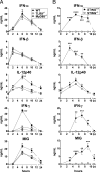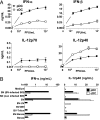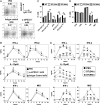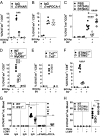Conventional but not plasmacytoid dendritic cells foster the systemic virus-induced type I IFN response needed for efficient CD8 T cell priming
- PMID: 24973449
- PMCID: PMC4105236
- DOI: 10.4049/jimmunol.1301440
Conventional but not plasmacytoid dendritic cells foster the systemic virus-induced type I IFN response needed for efficient CD8 T cell priming
Abstract
Plasmacytoid dendritic cells (pDCs) are considered to be the principal type-I IFN (IFN-I) source in response to viruses, whereas the contribution of conventional DCs (cDCs) has been underestimated because, on a per-cell basis, they are not considered professional IFN-I-producing cells. We have investigated their respective roles in the IFN-I response required for CTL activation. Using a nonreplicative virus, baculovirus, we show that despite the high IFN-I-producing abilities of pDCs, in vivo cDCs but not pDCs are the pivotal IFN-I producers upon viral injection, as demonstrated by selective pDC or cDC depletion. The pathway involved in the virus-triggered IFN-I response is dependent on TLR9/MyD88 in pDCs and on stimulator of IFN genes (STING) in cDCs. Importantly, STING is the key molecule for the systemic baculovirus-induced IFN-I response required for CTL priming. The supremacy of cDCs over pDCs in fostering the IFN-I response required for CTL activation was also verified in the lymphocytic choriomeningitis virus model, in which IFN-β promoter stimulator 1 plays the role of STING. However, when the TLR-independent virus-triggered IFN-I production is impaired, the pDC-induced IFNs-I have a primary impact on CTL activation, as shown by the detrimental effect of pDC depletion and IFN-I signaling blockade on the residual lymphocytic choriomeningitis virus-triggered CTL response detected in IFN-β promoter stimulator 1(-/-) mice. Our findings reveal that cDCs play a major role in the TLR-independent virus-triggered IFN-I production required for CTL priming, whereas pDC-induced IFNs-I are dispensable but become relevant when the TLR-independent IFN-I response is impaired.
Copyright © 2014 by The American Association of Immunologists, Inc.
Figures







Similar articles
-
Human Plasmacytoid and Monocyte-Derived Dendritic Cells Display Distinct Metabolic Profile Upon RIG-I Activation.Front Immunol. 2018 Dec 21;9:3070. doi: 10.3389/fimmu.2018.03070. eCollection 2018. Front Immunol. 2018. PMID: 30622542 Free PMC article.
-
Granzyme A Stimulates pDCs to Promote Adaptive Immunity via Induction of Type I IFN.Front Immunol. 2019 Jun 26;10:1450. doi: 10.3389/fimmu.2019.01450. eCollection 2019. Front Immunol. 2019. PMID: 31293597 Free PMC article.
-
Plasmacytoid dendritic cells cross-prime naive CD8 T cells by transferring antigen to conventional dendritic cells through exosomes.Proc Natl Acad Sci U S A. 2020 Sep 22;117(38):23730-23741. doi: 10.1073/pnas.2002345117. Epub 2020 Sep 2. Proc Natl Acad Sci U S A. 2020. PMID: 32879009 Free PMC article.
-
Plasmacytoid dendritic cells in antiviral immunity and autoimmunity.Sci China Life Sci. 2010 Feb;53(2):172-82. doi: 10.1007/s11427-010-0045-0. Epub 2010 Mar 7. Sci China Life Sci. 2010. PMID: 20596824 Free PMC article. Review.
-
Unraveling the functions of plasmacytoid dendritic cells during viral infections, autoimmunity, and tolerance.Immunol Rev. 2010 Mar;234(1):142-62. doi: 10.1111/j.0105-2896.2009.00881.x. Immunol Rev. 2010. PMID: 20193017 Free PMC article. Review.
Cited by
-
High-throughput quantitative real-time RT-PCR assay for determining expression profiles of types I and III interferon subtypes.J Vis Exp. 2015 Mar 24;(97):52650. doi: 10.3791/52650. J Vis Exp. 2015. PMID: 25867042 Free PMC article.
-
Silica exposure and chronic virus infection synergistically promote lupus-like systemic autoimmunity in mice with low genetic predisposition.Clin Immunol. 2019 Aug;205:75-82. doi: 10.1016/j.clim.2019.06.003. Epub 2019 Jun 5. Clin Immunol. 2019. PMID: 31175964 Free PMC article.
-
The role of plasmacytoid dendritic cells (pDCs) in immunity during viral infections and beyond.Cell Mol Immunol. 2024 Sep;21(9):1008-1035. doi: 10.1038/s41423-024-01167-5. Epub 2024 May 22. Cell Mol Immunol. 2024. PMID: 38777879 Free PMC article. Review.
-
Baculovirus Vectors Induce the Production of Interferons in Swine: Their Potential in the Development of Antiviral Strategies.Vet Sci. 2021 Nov 17;8(11):278. doi: 10.3390/vetsci8110278. Vet Sci. 2021. PMID: 34822651 Free PMC article.
-
Lupus acceleration by a MAVS-activating RNA virus requires endosomal TLR signaling and host genetic predisposition.PLoS One. 2018 Sep 10;13(9):e0203118. doi: 10.1371/journal.pone.0203118. eCollection 2018. PLoS One. 2018. PMID: 30199535 Free PMC article.
References
-
- Reis e Sousa C. 2004. Activation of dendritic cells: translating innate into adaptive immunity. Curr. Opin. Immunol. 16: 21–25 - PubMed
-
- Lee H. K., Iwasaki A.. 2007. Innate control of adaptive immunity: dendritic cells and beyond. Semin. Immunol. 19: 48–55 - PubMed
-
- Mescher M. F., Curtsinger J. M., Agarwal P., Casey K. A., Gerner M., Hammerbeck C. D., Popescu F., Xiao Z.. 2006. Signals required for programming effector and memory development by CD8+ T cells. Immunol. Rev. 211: 81–92 - PubMed
-
- Santini S. M., Di Pucchio T., Lapenta C., Parlato S., Logozzi M., Belardelli F.. 2002. The natural alliance between type I interferon and dendritic cells and its role in linking innate and adaptive immunity. J. Interferon Cytokine Res. 22: 1071–1080 - PubMed
Publication types
MeSH terms
Substances
LinkOut - more resources
Full Text Sources
Other Literature Sources
Research Materials

